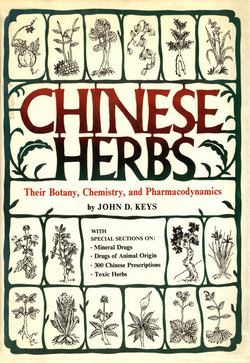Читать книгу Chinese Herbs - John D. Keys - Страница 7
На сайте Литреса книга снята с продажи.
FOREWORD
Оглавлениеby Ilza Veith, Ph.D.
Professor, History of Health Sciences
University of California
EVER SINCE its first contact with the Far East, the Western world has been irresistibly fascinated by the materia medica of China, by its promise of health, longevity, increased sexual potency, fertility, and rejuvenation.
It is for this reason that John D. Keys's work Chinese Herbs: Their Botany, Chemistry, and Pharmacodynamics is such a welcome publication. It provides an excellent and scholarly insight into most practical aspects of the herbal lore of China. Although not a complete description of all Chinese herb medications, it is a selection of those that appear most important to the author; these, incidentally, have become best known to the Western world.
In making his selection, the author has not failed to include ginseng root, which is said to cure all ills, to return youth and beauty, and even to confer the latter if it had not previously existed. A further sine qua non in all descriptions of Chinese herb medicine is the legendary Ma Huang, which was avidly accepted in the West, where it came to be known by its botanical name Ephedra sinica, and was synthesized as ephedrine to furnish an indispensable drug for the treatment of asthma and allergic reactions.
Many readers will view the extraordinary richness of the Chinese herbal pharmacopoeia with wonder, and question how it came into being. The secret of this development lies in the beginning of Chinese medicine, which is veiled in legend. Important in this legendary back-ground is the personality of an emperor of the third millennium B.C. This emperor, Shen Nung or "The Divine Husbandman," was deified by the people as the God of Agriculture for having given China its healing medicines, its rice and other foodstuffs, and all its agriculture.
To Shen Nung is also attributed the authorship of the first Pen Ts'ao, generally translated as the "Great Herbal." This vast book, which has been analyzed and annotated more than any other Chinese medical volume, is actually of-anonymous authorship. It contains descriptions of vegetable, animal, and mineral medicines and foodstuffs, and it was the forerunner of all later Chinese herbals.
The contemplation of the antiquity and anonymity of the Pen Ts'ao evokes certain parallels with Chinese Herbs here before us. It is well possible that the unknown Chinese herbalist who compiled the first Chinese pharmacopoeia was, like John D. Keys, an amateur in the true sense of the word: He loved to study plants for their healing virtue, but he was not a pharmacologist or a pharmacist. It is to be assumed that the earlier author was Chinese and familiar by birth with the spoken and written language of China. Mr. Keys early in life developed a passionate interest in things Chinese, particularly Chinese herbs. So strong was his interest that he studied the language —an endless undertaking so far as time and effort are concerned— and in eighteen years of single-minded devotion produced this interesting work.
At a time when Chinese culture, civilization, and particularly Chinese medicine occupy the forepoint of interest of the Western world, John D. Keys's contribution is bound to occupy an important place in the literature concerning the healing herbs of the immense country behind the Great Wall.
San Francisco
